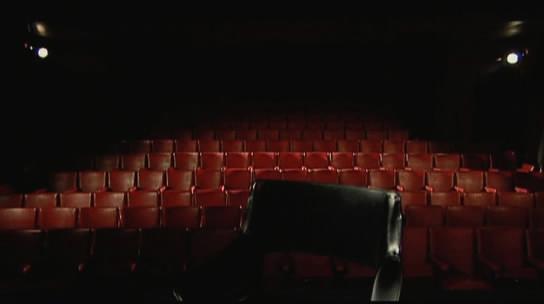The Transformative Potential of Global Cinema
archive


Screen grab from Jogo de Cena ('Playing') by Brazilian director Eduardo Coutinho, 2007.
The Transformative Potential of Global Cinema
What is Global Cinema? Well to begin with, it is a not a cinema at all. Often, forays into the study of what we call ‘Global Cinema’ focus on the interconnectedness of cinema production, funding, and the transnational flows of resources (both technological and human). In other instances, an analysis of Global Cinema may focus on particular tropes or types and how these are constructed, represented, and played out across various cinemas. Frameworks that reference geographic or linguistic boundaries are avoided as is the idea of the ‘national’ as a referent. This is different to the category of ‘World Cinema’, a cinema in which difference can be seen as neatly housed and framed and the spectator becomes a tourist-voyeur. The notion of a Global Cinema, deterritorialized from the geographic, spatial, and linguistic markers of place and nation, seemingly promises the viewer something, or at least the potential of something, an experience, a moment of learning that is not necessarily bounded by the story on screen.
Cinema tends to be perceived as a medium with a certain universality that does not suffer from the implicit contextual limitations of literature. In a previous publication in this series, Bella Li, in her exploration of poetry, asserts that “[t]o travel through a foreign text, as through a foreign country is to be reminded of the ways in which language is both a means and a limit.” In the case of cinema these linguistic ‘means and limitations’ are elided in favor of an assertion of the assumed accessibility of the visual. Indeed, as Paul Willemen has stated, “because image-discourses allegedly operated without having to pass through the narrow defile of a particular verbal language, cinema was often described as the first genuine universal ‘language’ capable of restoring humanity to its pre-Babel unity” (2006:96). The inadequacies of such understandings of cinema are fairly easy to outline, but we would assert that elements of this homogenizing narrative remain within approaches to a cinema that is transnational or transcultural. Stories resonate across borders, the human resources of cinema move across boundaries of place and language, and technology has produced a democratization of the production if not the consumption of cinema, in that it is not confined by the traditional boundaries of industry.
In 2016 we published an article titled Reading Across Cultures: Towards a Comparative Documentary Film Studies. In this article we considered the implications of cross-cultural spectatorship in the mediation of the filmic experience specifically in relationship to documentary cinema. What we were attempting to explore was both the limitations and the possibilities of the experience of viewing documentary films from a position that is dislocated both linguistically and geoculturally from the world portrayed on screen. We both linked our approach to previous calls for a comparative film studies1 and differentiated ourselves by focusing on documentary, “the most artisanal, immediate and localized of the audio-visual sub-genres” (Williams and McDonald, 677). The film we analyzed, Jogo de Cena (Playing), would seem in many ways to be the antithesis of Global Cinema: a Brazilian documentary, made by arguably the most famous Brazilian documentary filmmaker. The film sets out to frame and tell the personal life stories of a range of Brazilian women. Intensely personal, most of the documentary is comprised of mid-shots of these women, or well-known Brazilian actresses brought in to tell these stories on a stage as they speak directly to the camera. Our analysis was built around developing a shared meaning of the film by bring to bear one author’s expertise in documentary film and the other’s in Brazilian culture to explore the depth and layering of meaning that could occur in this shared viewership.
This brings us back to our present contention on Global Cinema. While the claim of learning from the viewing experience in and of itself is easy to make, and we don’t dispute that this possibility is always present, in our aforementioned article, as we do here, we wish to explore the limitations of this experience and what those limitations may in fact offer in and of themselves. The limitations we continue to challenge are those in the understanding of both documentary film and specifically Brazilian documentary film offered through this experience. When a viewer, naïve or expert, is confronted with the unknown in cinema there is an implicit awareness of the possibility of being unable to read the visual markers that are before you. If that experience is taking place in a language with which the viewer is unfamiliar or not proficient, it has the possibility of being profoundly destabilizing.

from Eduardo Coutinho's film Jogo de Cena (Playing), 2007.
This sense of destabilization opens for the viewer the possibility of enhancing their own cultural literacy by engendering “both a conceptual shift… and a more instinctive, ‘visceral’, form of unrest that… [unsettles] their views on culture, identity and the world at large” (García Ochoa, McDonald and Monk 550). Cultural Literacy has been defined by García Ochoa, McDonald and Monk as “the ability to read and interpret culture in its many manifestations (cultural artefacts)… opening up the possibility to modify such artefacts, or one’s attitude towards them” (García Ochoa, McDonald and Monk 547). The development of cultural literacy through destabilizing experiences like that of the viewer who engages with the unknown through cinema offers, then, an opportunity to develop their broader cultural literacy and to “understand and promote the richness of ‘difference’” (García Ochoa and McDonald, 353).
This definition of Cultural Literacy has focused on how we construct meaning when confronted with the unknown (in particular, unknown cultures, whose ideas one may not be literate on). It attempts to go beyond previously theorized understandings of intercultural competency and produce an applied understanding of the theories and analytical methodologies of literary and cultural studies. At the heart of this idea of Cultural Literacy is a quest to better navigate and understand the unfamiliar, but of course, the potential of advancing a greater understanding of the unknown necessarily fosters an increase in one’s awareness of the known, of the self, of one’s own context. This is, basically, self-reflection.
The development of cultural literacy through destabilizing experiences like that of the viewer who engages with the unknown through cinema offers, then, an opportunity to develop their broader cultural literacy...
These complimentary and multifaceted understandings of visual cultural products open a space for transformation. The development of cultural literacy in this instance is not only about a closer, deeper, more nuanced understanding of the previously unknown, although this is of course a hoped for by-product of the experience; rather it is about how this progression in creating meaning and understanding can be applied to the known context of one’s own cultural reality. In other words, how this applies to oneself, not only philosophically, but also in the most practical and mundane way. Paul Willemen raises this point when he asserts that “It is not simply a matter of engaging in a dialogue with some other culture’s products, but of using one’s understanding of another cultural practice to re-perceive and rethink one’s own cultural constellation at the same time” (Willemen, 2013, 38).
What we offer here is not a critique of Global Cinema as a cinema. This is in part because the authors do not wish to critique such a rich and fundamental part of the field of cinema studies, but also because to do so would be futile. Global Cinema is not a Cinema as we have sought to understand cinema before; as a category it is a response to the contemporary lived experience of cinema. The truly transformative potential embedded in the experience of Global Cinema is not that it opens a window to another, but rather, it opens a window to the reflexive self.
1. See Willemen, P. 2005 and Willemen, P. 2013.
García Ochoa, G., S. McDonald, and N. Monk. 2016. “Embedding Cultural Literacy in Higher Education: A New Approach.” Intercultural Education 27(6):546-559.
García Ochoa, G., S. McDonald. 2019. “Destabilisation and Cultural Literacy.” Intercultural Education 30(4):351-367.
Li, Bella. 2019. “‘By way of’: On Poetry, Translation and Translational Poetics’.” global-e 12(3), January 24, 2019.
Willemen, P. 2006. “The national revisited.” In Theorising national cinema, ed. V. Vitali and P. Willemen. London: B.F.I./Palgrave MacMillan, 29–43.
Willemen, P. 2013. “Introduction to subjectivity and fantasy in action: for a comparative film studies.” Inter-Asia Cultural Studies 14(1): 96–103.
Williams, D. and S. McDonald. 2015. “Reading across cultures towards a comparative documentary film studies: Eduardo Coutinho’s documentary Jogo de Cena (2007).” Critical Arts: A South-North Journal of Cultural and Media Studies 29(5):676-688.




